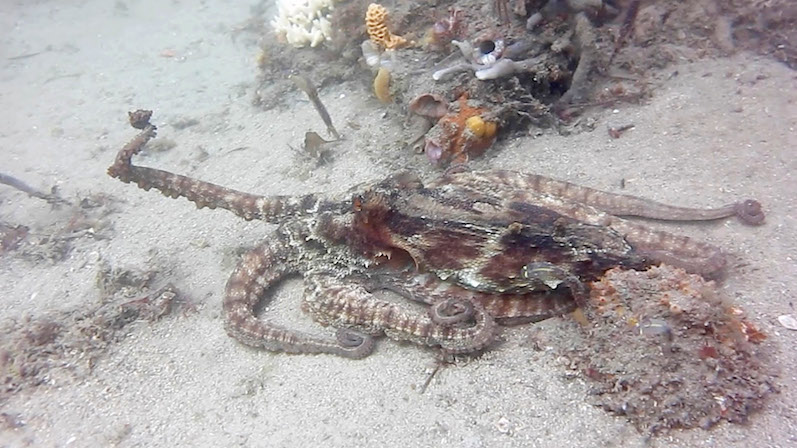While diving at Nelson Bay last month I came across this octopus roaming around. It was a large one, hunting among sponges in the late afternoon. At one stage while crossing an open area it began to move in a way I’d not seen before. It crawled along flat to the ground, with one arm – the left first arm – held out very straight, with the farthest part arranged in an upward spiral or helix.
As I say, this was new to me. This species often tends to move in – no offense – a sort of chaotic amble, with arms all over the place. When things get serious they use jet propulsion. This gait looked like something with a definite explanation. The obvious hypothesis is that it’s some sort of mimicry, imitation of something less edible. But who else moves along like a spirally rhinoceros, or a benthic narwhal, and might be worth imitating?
Here’s the video from which the photo above was taken:
One thing this behavior reminded me was some video I saw shown at a talk by Crissy Huffard, an octopus expert working in Indonesia and California. Here’s some footage of hers of an Indonesian species, Abdopus aculeatus:
The video is notable first because the octopus is walking on two legs. It’s also doing so in reverse – backwards bipedalism. But you can also see spiral positions held in several of the other arms. All this is probably in the service of camouflage, and more specifically, the aim may be to look like a piece of seaweed drifting across the bottom.
If so, it seems that the next comment to make is that Crissy’s delicate Indonesian octopus does look like a bit of seaweed, and the great big Octopus tetricus above does not look much like it at all. Octopus experts always say at this point: the fact that it looks that way to a human does not imply that it looks that way for the observers for which the display is intended, predatory fish. Fair enough. It might instead be that displays like this work so long as the animal doesn‘t look like an octopus, even if it doesn’t look much like something else – even if there’s no definite alternative being imitated. The rail-like arm certainly seems to fit that possibility. In any case, I’m still pretty curious about the spiral salute.


It reminds me of a lobster, if anything.
http://www.acquariofiliaitalia.it/news_letter/2007/febbraio/img/aragosta-newletter-gen2007.jpg
(although this is a Mediterranean specimen)
Good thought! Yes, it does look like that. More than it looks like seaweed, certainly.
Another thing this look may mean is that the animal was senescent, which would fit your size observation. In the aquariums we see a “corkscrew” arm look when the the octopus is stressed and when it is on its last “arms” so to speak. However, I don’t recall seeing the arms curled on a moving animal. It is usually observed on an animal near the surface and attached to a wall.
Here is a link to an end of life look for A. aculeatus. Note the arms in the first video. The next video shows it moving in the rocks but you don’t see the corkscrew to the arms while it is meandering.
http://www.tonmo.com/community/threads/durzo-a-aculeatus.15642/page-7#post-178612
That’s an interesting possibility, Denise – one of those things that only people who keep the animals would notice, too. This guy did look very vigorous, not at all ailing. But also large, which does indicate age.